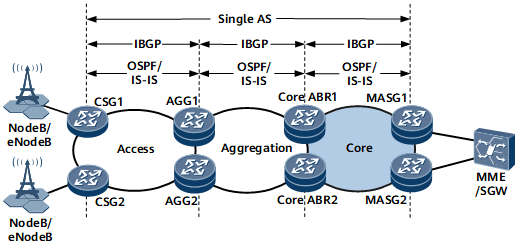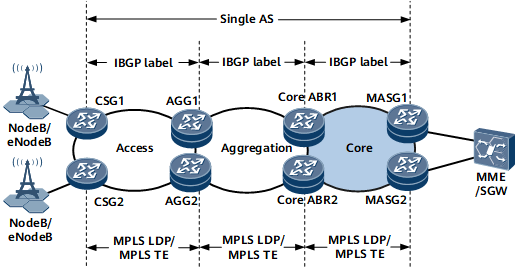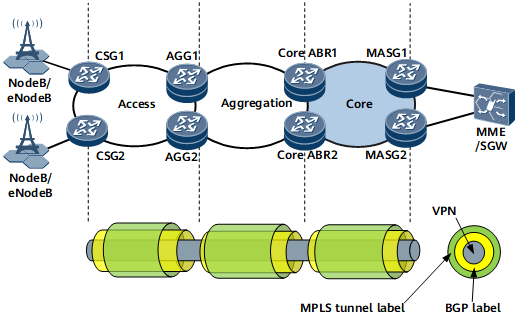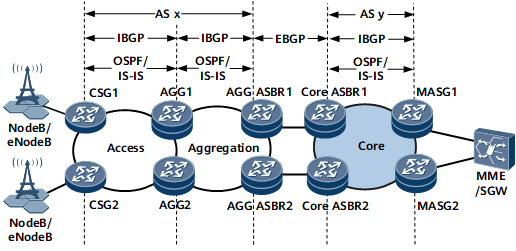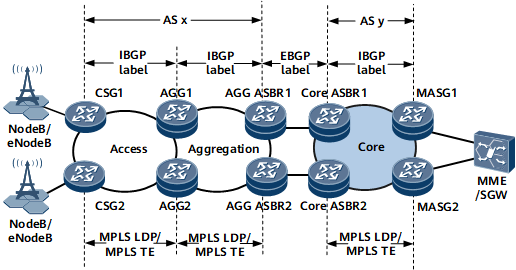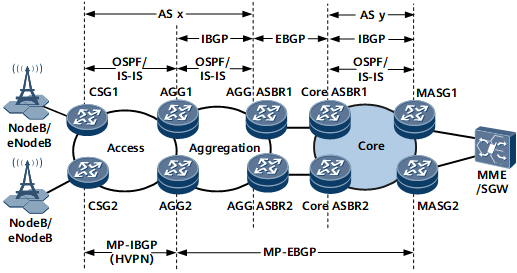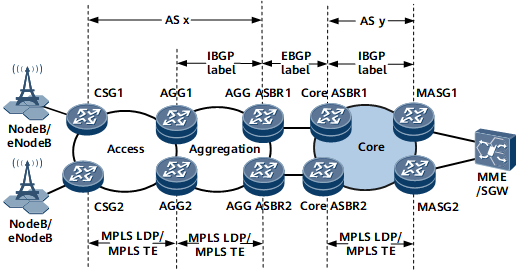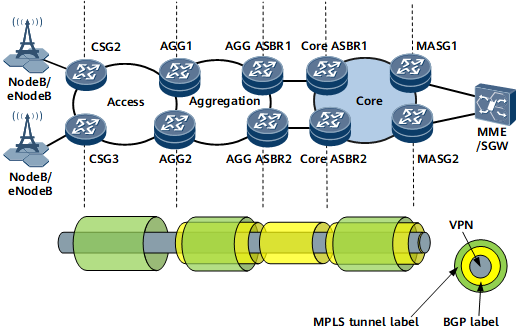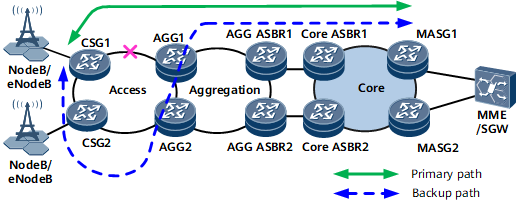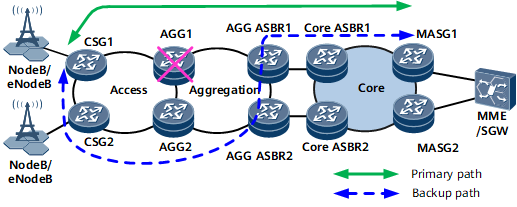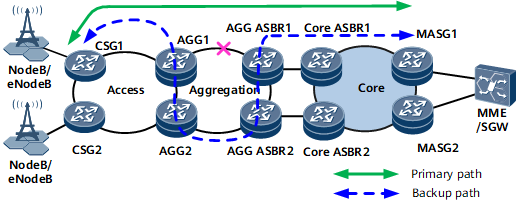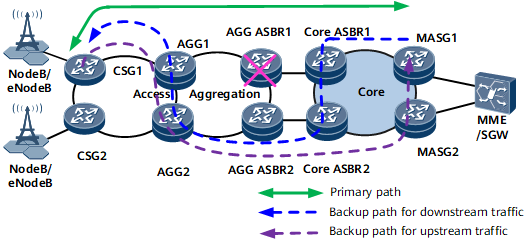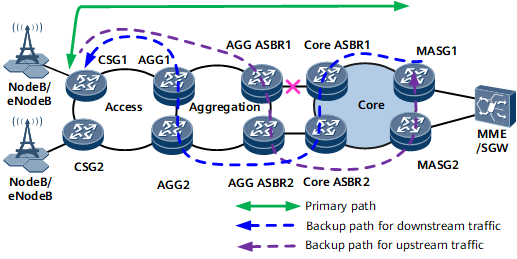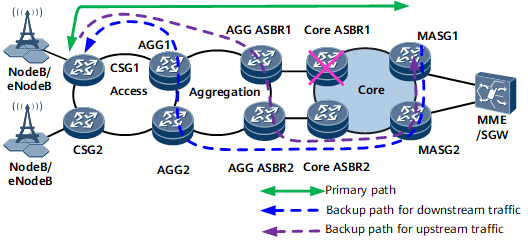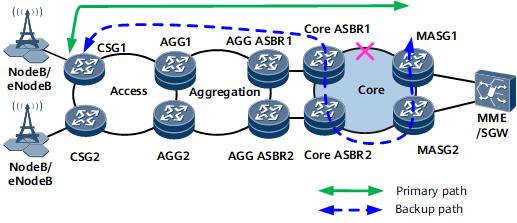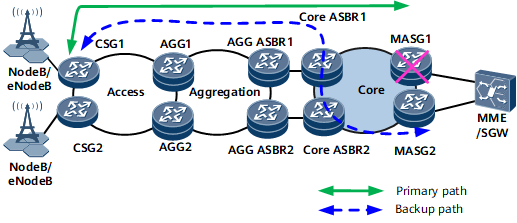Seamless MPLS Fundamentals
Usage Scenario
- Allows access nodes to signal all services to an LSP.
- Uses the same transport layer convergence technique to rectify all network-side faults, without affecting service transmission.
Seamless MPLS networking solutions are as follows:
Intra-AS seamless MPLS: The access, aggregation, and core layers are within a single AS. Intra-AS seamless MPLS applies to mobile bearer networks.
Inter-AS seamless MPLS: The access and aggregation layers are within a single AS, whereas the core layer in another AS. Inter-AS seamless MPLS is mainly used to transmit enterprise services.
Inter-AS seamless MPLS+HVPN: A cell site gateway (CSG) and an aggregation (AGG) node establish an HVPN connection, and the AGG and a mobile aggregate service gateway (MASG) establish a seamless MPLS LSP. The AGG provides hierarchical L3VPN access services and routing management services. Seamless MPLS+HVPN combines the advantages of both MPLS and HVPN. Seamless MPLS allows any two nodes on an inter-AS LSP to transmit services at the access, aggregation, and core layers, providing high service scalability. HVPN enables carriers to reduce network deployment costs by deploying devices with layer-specific capacities to meet service requirements.
Intra-AS Seamless MPLS
Network Deployment |
Description |
|
|---|---|---|
Control plane |
Deploy routing protocols. |
As shown in Figure 1, routing protocols are deployed on devices as follows:
|
Deploy tunnels. |
As shown in Figure 2, tunnels are deployed as follows:
|
|
Forwarding plane |
Figure 3 illustrates the forwarding plane of the intra-AS seamless MPLS networking. Seamless MPLS is mainly used to transmit VPN packets. The following example demonstrates how VPN packets, including labels and data, are transmitted from a CSG to an MASG along the path CSG1 -> AGG1 -> core ABR1 -> MASG1.
|
|
Inter-AS Seamless MPLS
Network Deployment |
Description |
|
|---|---|---|
Control plane |
Deploy routing protocols. |
As shown in Figure 4, routing protocols are deployed on devices as follows:
|
Deploy tunnels. |
As shown in Figure 5, tunnels are deployed as follows:
|
|
Forwarding plane |
Figure 6 Forwarding plane for the inter-AS seamless MPLS networking with a BGP LSP established in the core area
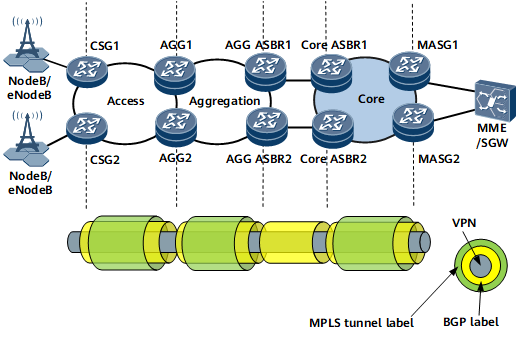 Figure 6 illustrates the forwarding plane of the inter-AS seamless MPLS networking with a core-layer BGP LSP established. Seamless MPLS is mainly used to transmit VPN packets. The following example demonstrates how VPN packets, including labels and data, are transmitted from a CSG to an MASG along the path CSG1 -> AGG1 -> AGG ASBR1 -> core ASBR1 -> MASG1.
Figure 7 Forwarding plane for the inter-AS seamless MPLS networking without a BGP LSP established in the core area
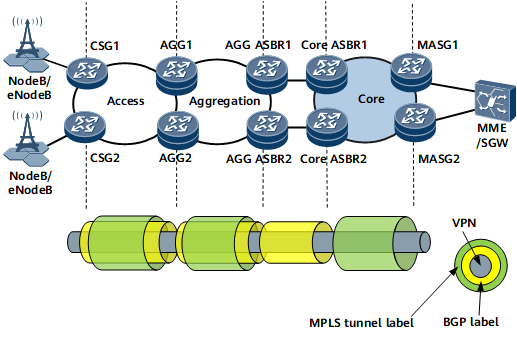 Figure 7 illustrates the forwarding plane for the inter-AS seamless MPLS networking without a BGP LSP established in the core area. The process of transmitting packets on this network is similar to that on a network with a BGP LSP established. The difference is that without a BGP LSP in the core area, the core ASBR removes BGP labels from packets and add MPLS tunnel labels to these packets. |
|
Inter-AS Seamless MPLS+HVPN
Network Deployment |
Description |
|
|---|---|---|
Control plane |
Deploy routing protocols. |
As shown in Figure 8, routing protocols are deployed on devices as follows:
|
Deploy tunnels. |
As shown in Figure 9, tunnels are deployed as follows:
|
|
Forwarding plane |
Figure 10 illustrates the forwarding plane of the inter-AS seamless MPLS+HVPN networking. Seamless MPLS is mainly used to transmit VPN packets. The following example demonstrates how VPN packets, including labels and data, are transmitted from a CSG to an MASG along the path CSG2 -> AGG1 -> AGG ASBR1 -> core ASBR1-> MASG1.
|
|
Reliability
Seamless MPLS network reliability can be improved using a variety of functions. If a network fault occurs, devices with reliability functions enabled immediately detect the fault and switch traffic from active links to standby links.
The following examples demonstrate the reliability functions used on an inter-AS seamless MPLS network.
A fault occurs on a link between a CSG and an AGG.
As shown in Figure 11, the active link along the primary path between CSG1 and AGG1 fails. After BFD for LDP or BFD for CR-LSP detects the fault, the BFD module uses LDP FRR, TE Hot-standby or BGP FRR to switch traffic from the primary path to the backup path.
A fault occurs on an AGG.
As shown in Figure 12, BGP Auto FRR is configured on CSGs and AGG ASBRs to protect traffic on the BGP LSP between CSG1 and MASG1. If BFD for LDP or BFD for TE detects AGG1 faults, the BFD module switches traffic from the primary path to the backup path.
A fault occurs on the link between an AGG and an AGG ASBR.
As shown in Figure 13, a fault occurs on the link along the primary path between AGG1 and AGG ASBR1. After BFD for LDP or BFD for CR-LSP detects the fault, the BFD module uses LDP FRR, TE hot-standby or BGP FRR to switch traffic from the primary path to the backup path.
A fault occurs on an AGG ASBR.
As shown in Figure 14, BFD for LDP or BFD for TE is configured on AGG1, and BFD for interface is configured on core ASBR1. If AGG ASBR1 fails, the BFD modules on AGG1 and core ASBR1 detect the fault and trigger the BGP Auto FRR function. BGP Auto FRR switches both upstream and downstream traffic from the primary path to backup paths.
A fault occurs on the link between an AGG ASBR and a core ASBR.
As shown in Figure 15, BFD for interface is configured on AGG ASBR1 and core ASBR1. If the BFD module detects a fault in the link between AGG ASBR1 and core ASBR1, the BFD module triggers the BGP Auto FRR function. BGP Auto FRR switches both upstream and downstream traffic from the primary path to backup paths.
A fault occurs on a core ASBR.
As shown in Figure 16, BFD for interface and BGP Auto FRR are configured on AGG ASBR1. BGP Auto FRR and BFD for LDP (or BFD for TE) are configured on MASGs to protect traffic on the BGP LSP between CSG1 and MASG1. If the BFD module detects a fault in core ASBR1, it switches both upstream and downstream traffic from the primary path to backup paths.
A link fault occurs in the core area.
As shown in Figure 17, BFD for LDP or BFD for CR-LSP is configured on core ASBR1. If the BFD module detects a fault in the link between core ASBR1 and MASG1, it triggers the LDP FRR, TE Hot-standby or BGP FRR function. LDP FRR, TE FRR, or BGP FRR switches both upstream and downstream traffic from the primary path to the backup path.
A fault occurs on an MASG.
As shown in Figure 18, BFD for BGP tunnel is configured on CSG1. BFD for BGP tunnel is implemented in compliance with relevant standards "Bidirectional Forwarding Detection (BFD) for MPLS Label Switched Paths (LSPs)." BFD for BGP tunnel monitors E2E BGP LSPs, including a BGP LSP connected to an LDP LSP. When MASG1 that functions as a provider edge (PE) device fails, BFD for BGP tunnel can rapidly detect the fault and trigger VPN FRR switching. The BFD module then switches both upstream and downstream traffic from the primary path to the backup path.
